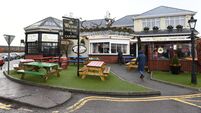Paul Rouse: You cannot be serious? How Wimbledon shaped sporting summers of Irish children

John McEnroe crashes to the ground after losing the 1980 Wimbledon final to Bjorn Borg 1-6, 7-5, 6-3, 6-7, 8-6. Picture: Rob Taggart/Central Press/Getty Images
Wimbledon starts next week.
It was at one time the case that this meant the appearance of tennis rackets across Ireland in the hands of those who did not otherwise play the game.
What happened to those tennis rackets across the remainder of the year was a triumph of recycling: They were used for rounders and walloping stones and crowd control in large families.
It is still the case that watching Wimbledon inspires an interest in tennis, but the potency of that inspiration is nowhere nearly as pronounced as it once was.
Every summer in the last decades of the 20th century, Wimbledon was a centrepiece of the sporting summer of Irish children.
It is a story that is told and retold in the memories of children all across Ireland. Some of these memories are captured in ’ history of Irish tennis. This is an extraordinary book — or, more accurately, books. Across three volumes and almost 1,800 pages, Higgins produced a painstaking record of tennis in from the invention of the game in the 1870s through to the new millennium. In its love of a game, its encyclopaedic knowledge, and its idiosyncratic charm, there is nothing quite like it in the history of Irish publishing.
There are accounts of the Irish men and women who won Wimbledon and US Open championships, of the history of every tennis club in the country and of the main competitions that have been organised.
But there is also a record of the informal playing of the game on city streets and country roads and out in farm fields. People are at the heart of this history, people who loved tennis and lived it as part of their everyday. Also, though, there is room for people who came at the game in a more impressionable way, people whose interaction with tennis was inspired more by a passing lust than a deep love.
The best part of the book focuses on ‘the magic of Wimbledon’. There is a description of the ‘rough tennis’ played every summer by Irish children imitating what they saw on television.
This includes the copying of mannerisms, hairstyles, grunting and gear. There were the shouts of ‘chalk dust’, a lá , and all manner of magnificent posing.
As Higgins notes, “They are translating the game of tennis from the centre court, Wimbledon, to the nearest suitable bit of ground. This link with and love of Wimbledon is difficult to define. It seems natural to children and those with a child-like approach to life.”
And the stories of this translation of the third-most watched sport in the world to lives is one that is truly diverse. It runs from a chalk line on a wall acting as a net, or a flowerbed or strip of grass running through tarmacadam serving the same function. This is a geography of sport where people make a virtue of necessity in pursuit of fun.
There are examples of fishing lines or bailer twine tied between trees or stakes, with maybe a blanket or a sheet thrown over them.
And there is, of course, the history of playing tennis at the beach. The scraping out of the lines of a court along sand that has been washed by the sea, a heel or a stick or the rim of a racket used to mark the often-crooked limits of play.
And long after the sea runs again across the sand, the memories live on. As Seamus Heaney wrote in ‘The Strand’:
Tennis stands as a game where hour after hour can be played alone. All that is needed is a ball and a racquet and a fairly solid wall. It is not easy to win a rally against a wall, but the great obsession lies in trying again and again, the pock of the ball lending an easy rhythm to the passing of time.
And passing time is a great joy of a teenage summer.
The thing is that this happened even before the arrival of television. People who heard the commentary of tennis matches on radio used their imagination still more to recreate the sounds that shaped the images that were remade.
What is most incongruous of all is the disconnect between ordinary Irish lives as against the insufferable self-regard and pomposity of the trappings of Wimbledon.
This is the world of strawberries-and-cream, the royal box, of Kent, ’s sonorous tones, ’s middle England blue-rinse brigade, absolute snobbery and a game which attracts some of the most irritating reactionaries in .
And yet it still inserted itself into Irish summers.
In part, of course, this is related to the impossible glamour of tennis stars and their lifestyles, where soap opera meets genuine sporting brilliance.
But of course that is no explanation in itself. It is also about the sheer pleasure of hitting a ball that can come back to you. Then hitting again, and again. And getting better at the hitting.
As Higgins notes: “All one requires is a battered ball, most likely of the bald variety, and possibly having the teeth marks of a canine supporter. The racquet may not be a Prince, but one left behind when Auntie Mary died. The fact that the strings were threadbare and loose did not matter.”
There is something else as well, when it comes to tennis – the possibility of romance hangs lightly in the air, gently colouring the atmosphere. There are relatively few sports where men and women have competed with each other across all of its history. There is no denying the discrimination against women that stains the history of the sport, but it remains the case that tennis was one of a limited number of spaces in the history of modern sport where men and women shared the same playing area.
It happened to some extent in golf, and extensively in hunting, but in tennis men and women could play sport together in shared sociability.
It was this point that helped draw people to tennis parties after patented the game in the 1870s. It was essential to the emergent culture of suburban tennis clubs that were established on every continent in the late 19th and early 20th centuries.
And it was also the lure to contact with the opposite sex that was part of the attraction of tennis clubs to many Irish teenagers.
Has all of this changed? And if it has all changed then why has this change occurred?
It would be a fool that would disagree that more Ireland children will take up tennis racquets during Wimbledon. They will.
What is different, however, is that so much sport is now on television that it is no longer as exciting to watch tennis.
It is too much to say that the game is lost in the sheer diversity of what is on offer, rather that it does not stand out in the same way that it once did.
And, in an Irish context, it is now more than a century since the country produced a truly world-class player. In the ferocious battle that happens on a daily basis for the loyalty of elite sporting talent on a small island, that matters.








